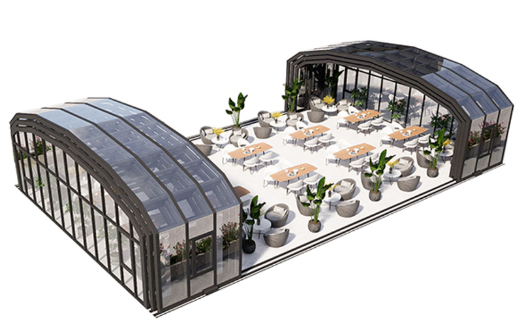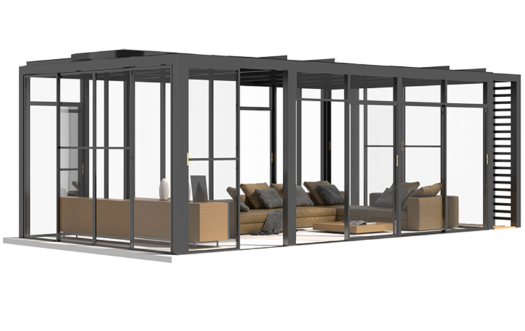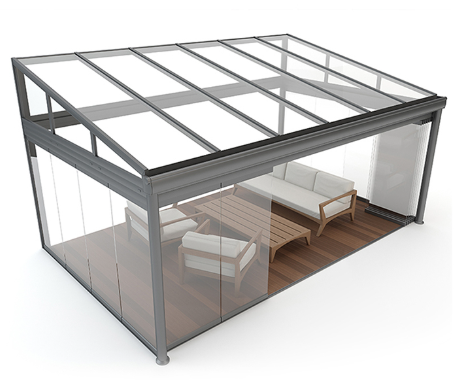
Key Sustainable Materials for Sunroom Construction
Energy-Efficient Glass Options for Windows and Doors
Low-e laminated glass performance glass is a wonderful option for sunrooms that are environmentally friendly! This special type of glass fights both inside and outside heat transfer as well as offering great defense from UV sun rays when it’s used on your windows and doors. Selecting this type of glass for use in your home design plan means you will have an interior with lower energy use. Second, with insulated laminated or vacuum available for your windows, it provides notch thermal insulation and insures your sunroom is always energy efficient for every season.
Eco-Friendly Insulation Materials for Optimal Temperature Control
Derived from 100% raw materials, cellulose fiber offers excellent thermal resistance while reducing landfill waste. Its dense structure blocks heat transfer, making it ideal for sunroom roofs and walls exposed to prolonged sunlight. Do a great job of regulating temperature. Proper insulation means less need for heating or cooling units, which helps save energy in the long run.
Cost Implications of Sustainable Sunroom Construction
Comparing Costs of Traditional vs. Sustainable Materials
Comparing the cost-effectiveness of materials with sustainable materials in the long term, sustainable materials are more advantageous with greater initial costs. For example, we conduct feasibility studies on sunroom profiles to determine if they can support loads, wind, and snow and resist fire, leading to longer durability and lower maintenance costs in the long term. Although investing in materials such as low-e glass or reclaimed wood might cost more upfront, the return they provide in terms of lifespan and functionality pays gigantic dividends in the future.
Long-Term Savings Through Energy Efficiency and Durability
Permitting the inclusion of energy-saving components like glazed windows or green insulation, reducing utility costs significantly in the long run. For instance, advanced settings in sunrooms enable the integration of smart home technology to further increase functionality. Such settings may come with options like rain sensors or remote control to boost energy efficiency through adjusting ventilation and lighting according to conditions in the environment.

Design Considerations for a Sustainable Sunroom
Incorporating Natural Light to Reduce Energy Usage
This needs natural lighting for energy saving in a sunroom design through the incorporation of large windows with top-of-the-line energy-efficient panes panes to provide sunlight to illuminate the room while reducing heat loss or gain in an efficient manner. Skylights, together with control systems, also maximize natural light and offer ventilation means as may be necessary.
Ventilation and Climate Control Solutions with Sustainability in Mind
Ventilation keeps the air quality and temperature in a sunroom within limits and comfortable levels for the occupants of the sunroom. Outward-opening hung windows are so designed that they allow free flow of fresh air even during rainy days without allowing rainwater to enter. Such windows not only provide better ventilation for better health but also have safety features such as child locks and anti-theft devices.

Steps to Build a Sustainable Sunroom
Planning and Securing Necessary Permits
Before you start working on your eco sunroom project, make sure to plan thoroughly and obtain all the necessary permits first and foremost. This initial stage is vital for adhering to the building codes and regulations in your area while also enabling you to integrate methods seamlessly into your design.
Choosing Contractors Familiar with Sustainable Practices
Hiring builders who specialize in construction methods guarantees that your dream is done successfully. Experts’ knowledge of amiable materials and methods can assist you in making rational choices concerning all aspects of designing and constructing your sunroom.
When designing a sunroom, you can create a space not only environmentally friendly but also economical for you to afford to utilize the great outdoors throughout the year! Companies like SUNRAY specialize in creating solutions for outdoor living spaces through the offering of customizable designs that accommodate different needs and offer lasting quality and performance over the long term. Its expertise in control systems also improves the application of contemporary sunrooms by incorporating smart technology into its narrow designs without compromising.
Feel free to contact them on their platforms to discover more about integrating eco-friendly means into your upcoming project or finding out about new and creative products from SUNRAY product line.
Enhancing Your Sunroom with Green Features
Adding Solar Panels for Renewable Energy Integration
Adding panels to the design of your sunroom is a significant move towards sustainability and eco-friendliness. Solar panels capture energy from the sun, which helps lessen our relianc, on finite energy sources and decreases utility costs. By incorporating technology into their sunroom setup, homeowners can effectively power their spaces while also playing a part in preserving the environment.
Integrating panels with smart control systems like the ones provided by SUNRAY allows for seamless operation in the home environment. These systems enable connectivity with homes for voice commands and remote access, via mobile phones. Moreover, they incorporate rain sensors to optimize energy efficiency during changing weather conditions ensuring that the sunroom remains both energy efficient and operational throughout different climatic conditions.
Creating an Indoor Garden Space with Native Plants
Converting your sunroom into a garden, with a native plants not only boosts its visual charm but also supports biodiversity effectively plants ware to the climate and need little water and care, making them an environmentally conscious option.T hey enhance air quality by purifying pollutants and emitting oxygen, enriching the living space with a healthier atmosphere.
To optimize this green feature, consider using high-performance laminated low-e glass for your windows and doors. This type of glass reduces heat transfer between the indoors and outdoors while effectively blocking ultraviolet radiation. Such features ensure that your indoor garden thrives without excessive reliance on artificial climate control systems.
The Future of Sustainable Sunroom Construction
Emerging Technologies in Eco-Friendly Building Materials
The direction of sunroom development is being influenced by new materials that focus on lasting quality and and eco-friendlinesss. Cutting-edge insulated e-glass and vacuum glass are leading the way in these advancements to reduce heat transfer both inside and outside while blocking harmful UV rays. Their exceptional thermal insulation capabilities make them perfect for keeping an indoor environment all year long.
Furthermore, corporations like SUNRAY are leading the way in developing architectural solutions such as portable sunrooms with advanced technologies. Portable sunrooms come with smart control systems that can be linked to smart home platforms, enabling remote control via mobile devices or voice prompts. These progressions improve the usability and eco-friendliness of contemporary sunrooms.
The Role of Homeowners in Promoting Green Building Practices
Homeowners are major demand drivers for green building practices. By making decisions on sustainable materials for their sunrooms, they are saving the environment and encouraging others to do so as well. Insulated low-e glass with superior performance capabilities can greatly reduce heat transfer both inside and outside. Further, encouraging policies beneficial to green building activities can ensure they become more effective in contributing to overall sustainability goals.
FAQ
Q: Do I need a permit for sunroom construction?
A: Certainly! It’s crucial to get a permit before kicking off your sunroom building venture as it guarantees alignment, with the area’s construction rules and standards that usually cover eco methods.
Q: How to maintain a sunroom after construction?
A: Regular maintenance involves cleaning windows and frames to prevent dirt buildup and inspecting seals to ensure waterproofing effectiveness. For sunrooms equipped with smart features from SUNRAY, periodic checks on electronic control systems are recommended to maintain optimal performance.
Q: How long does sunroom construction typically take?
A: The time it takes to build a sunroom can differ depending on factors like the complexity of the design and the availability of materials involved in the project completion process is estimated to last for a weeks, on average working with skilled contractors who are well acquainted with SUNRAY offerings can help make the construction more efficient through effective coordination and implementation.

Contact Us
Feel free to contact their channels for further details on using eco-friendly materials in your upcoming project or discovering creative solutions within the vast product selection offered by SUNRAY.






